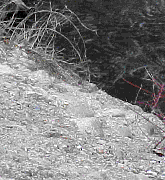


Excess fertilizers, herbicides, insecticides, and organic material from agricultural lands and residential areas, which causes excessive algae and weed growth;
Oil, grease, toxic chemicals, pesticides, and herbicides from urban runoff and energy production, which causes reduced aquatic diversity and is harmful to humans.;
Sediment and sand from improperly managed construction sites, crop and forest lands, and eroding stream banks. [The sediment destroys fish and insect habitat. Sediment may also cause local flooding] Some soil particles are primarily detached by raindrops but can also be detached by the shear forces resulting from overland or channel flow. Large sediment particles are less cohesive and therefore are more readily detached from the soil surface then the fine particles;
Salt from irrigation practices and acid drainage from abandoned mines; Which is normally described as the total dissolved solid (TDS) concentration. It can have specific damaging effects on soil and plants. Salts can cause clay particles to disperse and lose their permeability. Soluble salts in saline and alkali soils consist of calcium, magnesium, sodium, potassium, carbonate, bicarbonate, sulfate and chloride, and are easily leached from the soil.
Bacteria and nutrients from livestock, pet wastes and faulty septic systems; In simple terms, a pollutant is a substance that once it gets into the environment, tends to elevate the "natural" background level of that substance. In many cases, there may not be any amount of the "manufactured" substance there in the first place.